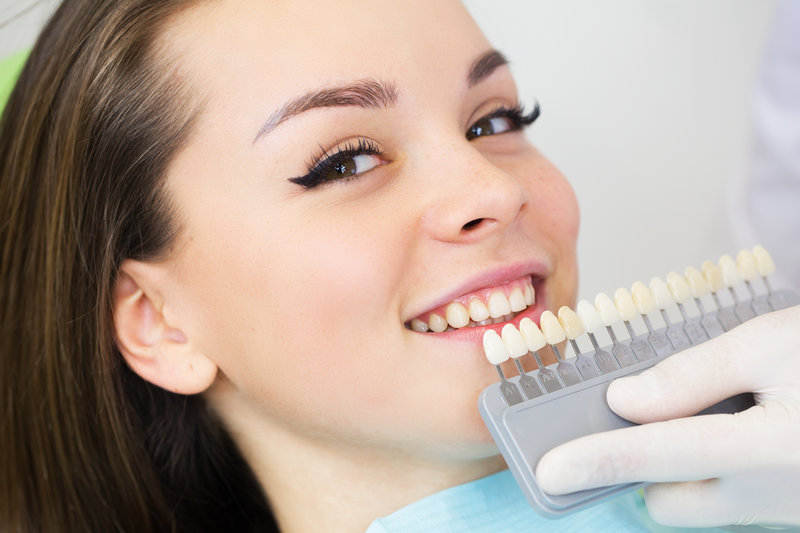Should Children Receive Teeth Whitening Treatment?
Avoiding Tooth Decay for Children and Adults
September 1, 2017Reasons People Love Braces
September 16, 2017
Close up portrait of a young women in a dentist chair, checking the whiteness of her teeth.
There are many people that want whiter, brighter teeth. The vast majority of teeth-whitening recipients are adults. However, what about children? What about teenagers? Who should receive teeth whitening and who can? There are various ways to whiten the teeth that include: gels, strips, in-office treatments and over-the-counter systems. What do each of these entail and what is the best option for getting brighter teeth? We can help you to know all about teeth whitening and if it is safe for children to use or not. We specialize in treating children’s teeth and want your child to receive the best and safest care possible. Learn more about whitening today and what options there are!
Your Teeth Change Over Time
Over time, you may notice that the teeth change from white to more of a dull yellow or gray. This is common over time even if you have whitened your teeth before. Foods and drinks are common culprits that change the color of the teeth, especially drinks with intense red or purple color pigments. Trauma, medications, tobacco use and coffee also change the color of the teeth.
Teeth whitening and teeth bleaching are two separate things. Bleaching the teeth involves using some form of bleach to make the teeth whiter. However, “whitening” can be used to describe any process that makes the teeth whiter, even if it’s just brushing plaque off the teeth. The American Dental Association tells us that hydrogen peroxide and carbamide peroxide are two of the main whitening bleaches that are used for
Teeth Whitening: How Does It Work?
The American Dental Association tells us that hydrogen peroxide and carbamide peroxide are the two main whitening bleaches used for teeth whitening. Both of these bleaches have the ability to break stains into smaller pieces. This makes the color less concentrated on your teeth, thus making them appear brighter. There are whitening toothpastes as well as over-the-counter and in-office whitening treatments. Whitening toothpastes generally do not bleach the teeth. When used with brushing, toothpaste helps remove plaque and food on the teeth, thus making them more polished and helping stains to stay away. If you use a toothpaste to make your teeth whiter, you may be waiting quite a long time.
There are over-the-counter methods of gels and tooth strips that contain bleach that can whiten your teeth at home. Many of these can be successful for making the teeth whiter in just a couple of weeks. However, the best option for whitening the teeth is an in-office treatment. With this treatment, you can receive a whitening that is done by a professional and that can make your teeth white in just one visit. Your dentist can also custom-make trays for your teeth that you can take home and whiten yourself.
Is It Safe for Children?
Many patients wonder if teeth whitening is safe for teenagers and children. The American Academy of Pediatric Dentistry (AAPD) tells us that there is a lack of research into the subject. However, amounts of hydrogen peroxide in whitening products (about 13%), can have adverse effects on children that are too young. The AAPD’s official stance is that whitening strips and gels are only safe for children and teens 15 years old and older. Why? Children and teens tend to misuse white strips and gels or use them wrong (such as wearing the whitening product too long or ingesting the product). The amount of hydrogen peroxide can also make children’s teeth more sensitive and even painful, while an adult may not have those adverse effects. However, for most children and young teens, if they have proper oral hygiene, they should be able to keep their teeth fairly white. The key is to brush and floss the teeth and to do it often!
Options for Better Smiles
The best option you have for keeping your child’s mouth healthy is to be vigilant with proper oral hygiene habits. These include brushing the teeth at least twice a day and flossing the teeth once a day. However, these are just basic guidelines. Brushing the teeth more than twice a day can help rid even more plaque from the teeth and keep your smile bright and clean all day long. For some patients, we also recommend a fluoride toothpaste or rinse to strengthen teeth that need it. Most children don’t use mouthwash, but mouthwash is something that can be beneficial for many patients who seek better breath. To relieve certain oral health problems, specific mouthwashes must be used.
Your Brighter Smile
As always, we recommend only using products that have the American Dental Associations Seal of Approval on the label. Only then can you be certain that the product you are using is safe and that the claims made have been evaluated. If you want a brighter smile or one for your child, exercise proper oral hygiene each and every day. We also recommend receiving a dental exam and cleaning every six months, if not more often. You can schedule your cleaning at Hardy Pediatric Dentistry and Orthodontics by calling (720) 887-6003. A brighter smile is possible today!